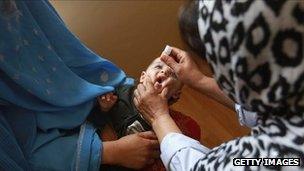Big drop in children under five dying, says UN report
- Published

Afghan child being immunised against polio
The number of children under five who die each year has plummeted from 12 million in 1990, to 7.6 million last year, the UN says.
The reasons for the change include better access to health care and immunisation, says .
But they warn that more needs to be done to reach UN development goals on reducing child mortality.
About 21,000 children are still dying every day from preventable causes.
But even the poorest regions have made progress. Child mortality in sub-Saharan Africa is declining twice as fast as it was a decade ago.
"Focusing greater investment on the most disadvantaged communities will help us save more lives, more quickly and more cost effectively," said Anthony Lake, the executive director of Unicef.
Many factors are contributing to reductions in child mortality, including better healthcare for newborns, prevention and treatment of childhood diseases, clean water and better nutrition.
Most improved
Sierra Leone in West Africa - one of the world's poorest nations - ranks among the top five countries seeing improvements in child mortality in the past decade. The others were Niger, Malawi and Liberia - also in Africa - and East Timor in South East Asia.
One of the reasons for Sierra Leone's success is that the government scrapped all fees for child and maternal health, said Ian Pett, the chief of health systems at Unicef.
About half of all deaths among under fives in the world took place in just five countries in 2010 - India, China, Pakistan, Nigeria and Democratic Republic of Congo.
Babies are particularly vulnerable. According to the report, more than 40% of deaths in children under the age of five occur within the first month of life and more than 70% in the first year of life.
In sub-Saharan Africa, one in eight children die before reaching the age of five. That compares with one in 143 children dying before five years old in developed countries.
- Published10 June 2011
- Published16 August 2011
- Published7 September 2010